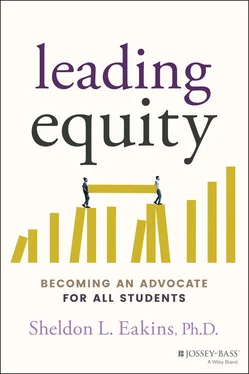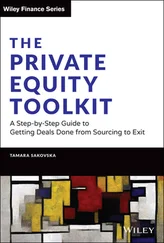Sheldon L. Eakins - Leading Equity
Здесь есть возможность читать онлайн «Sheldon L. Eakins - Leading Equity» — ознакомительный отрывок электронной книги совершенно бесплатно, а после прочтения отрывка купить полную версию. В некоторых случаях можно слушать аудио, скачать через торрент в формате fb2 и присутствует краткое содержание. Жанр: unrecognised, на английском языке. Описание произведения, (предисловие) а так же отзывы посетителей доступны на портале библиотеки ЛибКат.
- Название:Leading Equity
- Автор:
- Жанр:
- Год:неизвестен
- ISBN:нет данных
- Рейтинг книги:4 / 5. Голосов: 1
-
Избранное:Добавить в избранное
- Отзывы:
-
Ваша оценка:
- 80
- 1
- 2
- 3
- 4
- 5
Leading Equity: краткое содержание, описание и аннотация
Предлагаем к чтению аннотацию, описание, краткое содержание или предисловие (зависит от того, что написал сам автор книги «Leading Equity»). Если вы не нашли необходимую информацию о книге — напишите в комментариях, мы постараемся отыскать её.
Leading Equity Things you can do today to advance the cause of equity in your classroom, from reconsidering your language choices to getting to know yourself and your students Using social justice as the basis for your advocacy for equity How to promote a decolonial atmosphere and model vulnerability and humility for your students and colleagues Ideal for educators and educational leaders at all stages of their careers,
will help you improve your ability to offer an equitable environment to all of your students.
Leading Equity — читать онлайн ознакомительный отрывок
Ниже представлен текст книги, разбитый по страницам. Система сохранения места последней прочитанной страницы, позволяет с удобством читать онлайн бесплатно книгу «Leading Equity», без необходимости каждый раз заново искать на чём Вы остановились. Поставьте закладку, и сможете в любой момент перейти на страницу, на которой закончили чтение.
Интервал:
Закладка:
Yes? Okay, guess what? My circle of trust would be the same. I would have lots and lots and lots of checks. Although I live in Idaho, I would still have a lot of checks next to those who I trust. This is called affinity bias . It's not necessarily a bad thing.
We typically like to hang around or interact with people who are like minded and who are similar in age, race, and gender. We typically gravitate toward that. Married people tend to hang around other married people. Married people with kids tend to hang around with married people with kids. Single folks tend to do the same. It's not a bad thing to have an affinity bias. We gravitate to or are attracted to things or people who are very similar to us. We can have a conversation with someone who shares a lot of the same political views as us or who shares the same interests that we have—that's fine. But let's consider ways to connect with people outside of our social circles.
Steps to Building Relationships
How can you develop meaningful relationships with students who don't look like you? When we can become more aware of our biases, we can start to improve upon our interactions with others, decrease our sense of discomfort in interacting with social groups different than our groups, and ultimately make better decisions. Use the following guide as a starting point for developing authentic relationships with students from diverse backgrounds.
| My Students… | Try This! |
|---|---|
| …have a different ethnic or racial background than me. | Celebrate your students' rich cultural heritage. One simple way to do this is by expressing a genuine interest in their backgrounds. Invite students to incorporate their culture into the learning artifacts they produce. Another way to celebrate students' racial and ethnic backgrounds is to show your appreciation by representing individuals from those backgrounds in your classroom resources and curriculum. |
| …speak a different language than me. | Students who speak a language other than English as their first language are often viewed through a deficit lens. Value your students' linguistic diversity as enriching, not limiting. Try incorporating content-specific vocabulary in multiple languages into your lessons. This will position you as a learner right alongside your students! |
| …have different cultural norms than my norms. | Many students subscribe to a different set of cultural norms at home than the dominant norms imposed at school. Seek to understand and respect your students' cultural norms, especially in the process of creating your own classroom procedures or community agreements. Invite students to be equal partners in this process as you construct a learning environment that supports the safety and success of all. |
| …are much younger than me. | Individuals across generations often have shared interests—you just must discover them! Discuss your interests with your students and allow them to share their interests with you. You may be surprised by what you find! Try to make an intentional effort to incorporate your students' interests in your classroom learning activities. |
| …dress differently than me. | Be aware of your implicit biases and take steps to mitigate them. Focus on each student as an individual learner with unique strengths and talents. Incorporate strategies such as student interest surveys or classroom circles to get to know each student beyond the surface level. |
Your Bias Is Showing
Although we may not realize it, implicit bias impacts the decisions we make as educators. I have biases; we all do. Does that make us bad people? No, I don't think so. In fact, biases are part of human nature. However, I believe it's essential that we recognize and own those biases that we have and find ways to overcome and challenge them.
The Ohio State University's Kirwin Institute, a leading research group in the field of implicit bias, defines implicit bias as the attitudes or stereotypes that affect our understanding, actions, and decisions in an unconscious manner.
Often, the biases that we have come from stereotypes, and they're implicit, meaning they're unconscious. We're not necessarily thinking about the situation; they're just revealed by things we do that may come from our backgrounds, lived experiences, and social circles. The important thing is to check yourself whenever you notice that you are acting on your biases. Take a step back and reflect. Why was this my immediate reaction? Why did I respond this way? How could I have responded? How should I answer the next time a situation like this arises?
Implicit Bias and Me
How do I cope with implicit bias when it happens to me? The following is an individual reflection guide that will help you unpack your personal experiences with implicit bias as both an agent of bias and a recipient of bias.
Reflect on a time you have been on the receiving end of implicit bias:
What emotions did you feel?
Did you choose to address the bias? Why or why not?
How did this situation impact how you were treated by others?
Were you satisfied with how the situation was resolved? Why or why not?
How did this situation influence your future behaviors or beliefs?
Reflect on a time you have acted out of implicit bias toward someone else:
What emotions did you feel during the interaction? After the interaction?
Did you address the bias once you recognized it? Why or why not?
What harm did this interaction cause to the individual or community? Were you able to repair it?
How did this situation influence your future behaviors or beliefs?
Implicit Bias Analysis Guide
Let's take a moment to analyze our personal beliefs. The following is a two-part tool that will help you unpack specific behaviors to identify if those behaviors may be rooted in implicit biases. This tool consists of a list of yes/no questions and a brief reflection for each question.
| Part 1Carefully read each statement in this column. Circle “Yes” if the statement accurately reflects your beliefs or behaviors.Circle “No” if the statement does not accurately reflect your beliefs or behaviors. If you have never been in the scenario described, do your best to predict how you might respond in the situation. | Part 2If you circled “Yes” for any of the statements in the left column, reflect on the ideas, perspectives, and questions outlined in the following text. Consider how your behaviors may be influenced unconsciously by specific attitudes or stereotypes. |
| I prefer to watch news channels that do not make a big deal about race. I would rather hear about the positive things happening in the world! Yes No | We know that media bias can influence our feelings toward topics covered in the news, including race. Additionally, our discomfort around race topics may engender a biased, negative perception of racial issues in the media. How does talking about or hearing about race make you feel? Anxious? Nervous? Uncomfortable? Try to isolate the factors that trigger these feelings to begin the process of identifying unconscious bias. |
| When someone brings up race at work, I try to change the subject. Race is an inappropriate topic to discuss in a professional environment. Yes No | Race is a component of identity, and identity influences how we interact with each other in a variety of settings. In your professional context, is it essential for you to understand how your co-workers experience the world? Why or why not? What is accomplished or sacrificed by avoiding discussions about race in professional settings? |
| If one of my friends makes an insensitive joke about race or gender, I will just ignore them if no one from that race or gender is around to be offended by it. Yes No | How do you gauge who should be offended by an insensitive remark? If you recognize a comment as insensitive to a particular group of people, does that comment offend you? Why or why not? What are the implications of remaining silent when you hear racist or sexist comments? What are the potential ramifications? |
| I am friends with people from different cultural backgrounds, but I do not invite them to social gatherings because I know they would not be comfortable. Yes No | Consider the individuals you interact with on a social level. How diverse is your social universe? What factors contribute to the cultural diversity of your friend groups? What elements of a typical social gathering do you think might prompt discomfort for individuals of a different cultural background? |
| If a student's name is hard to pronounce, I try to avoid saying it in front of the class so they will not be embarrassed. Yes No | If you publicly mispronounce a student's name, how will you feel? Embarrassed? Are you centering the student's feelings or your own? What is the consequence of refusing to say a person's name? What does this imply about the importance of his/her identity? |
| I try to make sure that I speak loudly and slowly when I meet people who look like they are from a different country so they will understand me better. Yes No | Should we assume that individuals who dress in a way that reflects a cultural or ethnic background are not American? How might our actions convey an assumption that people who speak a language other than English are somehow impaired or deficient? |
| I generally choose professionals who are older than me because they probably know what they're doing. Yes No | What assumptions might you hold about the competence of young professionals? What stereotypes about younger generations might support young people's perceptions that they are less capable, less professional, or less intelligent? |
| When I enter a room full of strangers, I seek out people who look like me (similar age, same gender, similar style of dress). Yes No | We often seek out familiarity to increase our sense of comfort or security in unfamiliar situations. Why do you think this is? Does diversity cause us discomfort? Is diversity inconvenient? |
| When I go to the bank, I will let people in front of me in line so I can wait for a nicer or friendly-looking teller to become available. Yes No | How does a nice person or a close individual look? Can a skin color look unfriendly? What about a hijab? How might your conception of a “nice” appearance have been influenced by your environment, beliefs, or upbringing? |
| I have ended a romantic relationship because I felt too uncomfortable with an aspect of the person's physical appearance (e.g., physical disability, skin color, weight). Yes No | You've likely heard the saying that opposites attract, but what differences qualify as insurmountable? Think about the differences you are willing and unwilling to accept in a romantic partner. How many unacceptable features are physical traits? What might this indicate about your unconscious biases? |
| When I buy gifts for children, I look up toys that are popular for little girls or little boys, depending on their gender. Yes No | What assumptions do we make about gender as it relates to children's interests and abilities? What harm might those assumptions potentially impose on young children? |
| When I notice a same-sex couple in public, I try to pretend like I don't see them. I am sure they would not appreciate being singled out. Yes No | When you see a same-sex couple in public, what feelings do you notice within yourself? Often, we may react to discomfort with avoidance. However, choosing to ignore individuals who are different from us is committing an erasure that ultimately can perpetuate harm and overlook injustice. |
| I treat all my students the same regardless of their physical characteristics or cognitive abilities. That's the fair thing to do. Yes No | What is the difference between equality and equity? Is it possible to meet students' individual needs without acknowledging their unique identities, backgrounds, and characteristics? |
| I have asked to switch seats at a restaurant or on a plane to distance myself from a person who is dressed strangely. Yes No | What qualifies as “strange” attire to you? What assumptions do we hold about culture or class that might inform the level of threat that we infer from a person's appearance? |
| If I see a person paying with coupons or food stamps at the grocery store, I will try to pick a different checkout line. Yes No | Taken at face value, this may seem like a decision based purely on convenience and efficiency. However, think deeply about what thoughts or emotions this situation creates for you. What assumptions about socioeconomic class might influence your decision to distance yourself from an individual using coupons or a government assistance program? |
| If I noticed a person making strange involuntary noises in public, I would call the police. That person could be a danger to themself or to someone else. Yes No | When you recognize signs of mental illness, how do you react? How does your knowledge about a particular behavior or disorder inform that reaction? What assumptions do you hold about individuals who live with mental illnesses? |
Implicit Bias Talk Moves
Интервал:
Закладка:
Похожие книги на «Leading Equity»
Представляем Вашему вниманию похожие книги на «Leading Equity» списком для выбора. Мы отобрали схожую по названию и смыслу литературу в надежде предоставить читателям больше вариантов отыскать новые, интересные, ещё непрочитанные произведения.
Обсуждение, отзывы о книге «Leading Equity» и просто собственные мнения читателей. Оставьте ваши комментарии, напишите, что Вы думаете о произведении, его смысле или главных героях. Укажите что конкретно понравилось, а что нет, и почему Вы так считаете.












